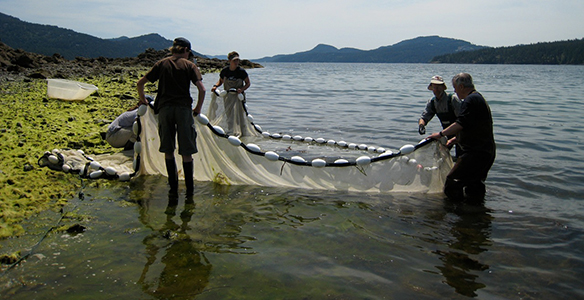||| CLIMATE EYES by STEVE BERNHEIM |||
The San Juan County Council met last Monday, September 18 to release its greenhouse gas study which attempts to quantify human-caused greenhouse gas emissions originating in the county as well as those human-caused emissions occurring elsewhere that are associated with county residents’ activities, and to accept a $300,000 state climate planning grant.
Quantifying and identifying the “geographic” emissions (those occurring within the county) and the “consumption-based” emissions (those occurring anywhere in the world resulting from the activities of county residents) is one of the first steps in becoming able to systematically develop plans to reduce greenhouse gas emissions, here and elsewhere.
The good news is that San Juan County’s electricity causes fewer greenhouse gas emissions than electricity in most locations because it comes primarily from the Bonneville Power Administration (BPA) which sells electricity from dams on the Columbia River that do not emit substantial greenhouse gases according to many measures, while most cities and counties across the country rely on electricity from coal, natural gas or fuel oil which produce large amounts of greenhouse gases. Whether BPA remains a viable long-term source of electricity remains to be seen as salmon and orca species disappear and water supplies dry up, but for the time being, San Juan County enjoys a lower-than-average greenhouse gas profile because we do not have substantial carbon emissions associated with our county’s unlimited electricity consumption.
Locally, about 177,000 metric tons of carbon dioxide equivalent (MTCO2e) emissions emerged from the geographic confines of San Juan County in 2019, according to the report. Most of this carbon dioxide was pumped into the air by the local ferries (20% of all emissions), auto and truck travel on local roads (18%), and (surprisingly) recreational boating (18%). Tree loss, i.e., emissions that occur when trees are cut down for timber harvest, land clearing or forest and fire management, accounted for a whopping 13% of county emissions. (Page 25.) Timber harvest is said to account for 78% of the 2019 tree loss. The county’s remaining 30% of its total emissions came from off-road vehicles (7%), heating buildings with propane and fuel oil (7%), solid waste processing (5%), escaping refrigerants (5%), livestock and electric generation.
For the most part, because wood fuel burned to heat homes is considered “biogenic” and not “anthropogenic” or “human caused,” it is not accounted for in these totals. Biogenic wood burning emissions were estimated to be, yes, a whopping 40,000 MTCO2e and are reported separately because technically, over time, the carbon contained in the wood would have been released naturally into the atmosphere without human intervention. “While wood only contributes a small amount to the anthropogenic total of communitywide emissions, it is still an inefficient heating source when compared to fuel oil and propane when the biogenic emissions are also taken into consideration.” (p. 18.). In other words, wood burning stoves release a whole lot of carbon emissions even if they are not, technically, human-caused in the same way that burning fossil fuels are.
But what we generate locally even adding in the wood smoke is much less than what we generate elsewhere. County residents were responsible, according to the report, for 308,000 additional MTCO2e in 2019 from emissions outside of the county (such as when a county resident drives to Costco or orders a blender from Amazon). Most residents’ consumption-based emissions came from transportation impacts (36%), but local demands for services accounted for 23% of the consumption-based emissions.
Gasoline was by far the largest single factor, about 14% of the total household consumption-based emissions calculations, followed by healthcare broadly, which is said to be responsible for 7% of county household emissions.
The search for food contributed 21% of the household food-related emissions, with plant-based food accounting for about 20% while animal-based foods and eating out was said to account for about 80%. The report observes on page 39 that animal-based foods have an “outsized impact” on the typical household’s emissions because of the emissions from the animals themselves and from the extensive food-system necessary to feed all the animals during their lifetimes. Moreover, since US households purchase more calories per person per day, about 3,800, more than any other country, additional
wasteful emission result when the average household eats more than it needs and throws away 30-40% of its food.
Oddly, and bizarrely optimistically, the report suggests county greenhouse gas emissions “have seen an overall decline” since 2007, even though according to the data presented on page 34 of the report emissions have seen an overall increase since 2010.
The impact of visitors to the county is briefly addressed, the report concluding that while local residents were responsible for 308,000 consumption-based MTCO2e in 2019, visitors and tourists to the county generated an additional 180,000 consumption-based MTCO2e during their visits because “just over 1 in 3 people on the islands on an average day is a visitor.” (Page 42.)
So, what to do ? The report makes several suggestions, including transitioning to emissions-free vehicles and “where feasible” supporting alternative modes of transit such as biking, walking, and buses. (Page 45.) The report also suggests exploring policies to encourage a dietary shift away from imported red meat, focusing on locally caught fish and/or reductions in meat consumption, generally, along with strategies to reduce food waste.
To reduce the actual local geographic emissions, including those from ferries, cars, trucks and tree-cutting, the report recommends actions aimed at:
- Sustainable maritime transport
- Reduction in vehicle miles traveled
- Expansion of electric vehicle infrastructure
- Enhanced tree preservation & management
- Building electrification and
- Building energy efficiency
To reduce consumption-based emissions caused by the activities of county residents but resulting in
emissions outside of the county, the report identifies potential reduction strategies such as:
- Reduction in vehicle miles traveled
- Expansion of electric vehicle infrastructure
- Expansion of safe walking and biking infrastructure, and
- Community education and engagement around plant-based foods
The county will receive a $300,000 state grant this year to help plan for and implement emissions reductions and steps necessary to withstand global warming such as inundation of low-elevation roadways and erosion from storms.
Whether county emissions will ever decline was said at the meeting to depend upon a program of community education and civic engagement.









I can think of a whole lot of better uses for $300,000 of public money than yet another report generated by overpaid consultants. How about we actually DO something useful with our tax dollars for a change?
It’s not like we don’t already know what needs to be done to reduce our ecological footprint. Fixating on our contribution to global carbon emissions to the exclusion of all the other local impacts of the human presence in the islands is unlikely to produce the kind of changes that are needed here. Insulate your house. STAY HOME. Use a clothes line. Don’t fly. Use it up, wear it out, make do and do without!
35 years ago Orcas was a place where an old mended flannel shirt and a old island car were worn and driven with pride. I miss that working class egalitarian ethos and I think that unless we embrace
Steve, thank you very much for going to these meetings and reporting to us. However, I completely agree with Ken Wood.
Thanks to you, Steve, we are now at least aware of this unnecessary expenditure by our state of our tax money.
I very much like the name, Climate Eyes!!!
Assuming a County population of 19,000, that 177,000 metric tons translates to 9.3 metric tons per person, which sounds really good, although we benefit from BPA power. When you add in the 308,000 metric tons for off-island consumption, however, it becomes 25.5 metric tons per person, which is not so good.
What Ken Wood says, so much more eloquently and briefly. Thanks for this latest report and for attending these meetings.
So, is all the money going to the ‘planning’ with nothing left for implementing the ‘plan?’
Um; gorillas in the living room …. aviation growth? Jet fuel? Growler and other military plane ‘war games’ so we can watch our federal and state governments thros ‘defense’ money at another proxy war of aggression? Point Roberts plan? Infrastructure Bill not earmarked to fix the ferry issues? Huge broadband grant rollout including pushing 5G for that 24-7 ‘connectivity’ and ‘virtua’l realities? Impacts from unlimited unmitigated growth in an ‘urban growth area’ that sits atop Lummi and other Co-Salish burial grounds – not to mention how this mile wide (formerly) forested wetland watershed – source of our drinking water – would easily be wiped out and completely depopulated by a tsunami or wildfire?
IMO, the first step is to divest ourselves from this language that dumbs down the English language into buzzword feel-good euphemisms. It is helpful to learn to decipher the code, avoid and eschew what’s behind words like “Smart’ city/island/meter/phone. ‘Green’ new deal, ‘Clean’ energy, ‘build back better,’ ad nauseum. The devil is in the details – but one has to look and face the details, not turn away from the unpleasant and inconvenient truths.
One local impact of this is 5G on the islands, driven by global telecoms. Have we even tried to appeal to them en-masse or get our Councilors to DO SOMETHING that actually represents our wishes? There is so much inarguable research out about the hazards of 5G on health, bee and bird migrations, cause of cancers, mental health issues. We were promised that 4G was adequate but when you have a global corporation dictating what we can have, we all have to have it – against our will -and the dire health warnings that come with it. Unless we coordinate and activate.
Presently, the SJIs use hydro to push the all-electrification agenda. But what about the other options NOT being discussed to support ‘all electric’ – like so-called ‘clean’ nuclear, and the dirty mining to support all-electric charging stations for these EVs being pushed in land, sea, and air? What about all those ‘smart’ cars? ‘Smart’ scooters catching fire – the lithium ion batteries are flammable – explosive, even. What kind of a footprint does that leave if one of those starts the ‘wildfire’ similar to what happened in Lahaina? Why can we not see this for what it is? My mind reels at how little real thinking goes into the ‘next big thing’ before everyone marches lockstep to the drumbeat. Sorry to burst anyone’s ‘virtual’ bubble, but this is not real or sustainable. We are supposed to be able to question, be skeptical, ask for proof of safety and veracity of claims of how great something is, for example.
An aside, but related: these past few nights of planned outages allowed us here in the Urban Growth Area some peace and desperately needed Quiet and Dark Sky for a change. I slept better than I have in my 20+ yrs living in Lavender Hollow. My cat, who is sick – hyperthyroid and kidney disease – is normally agitated all night long. he was calmer and slept better too, these past two nights so far. Animals don’t lie. Some of these EMFs are disturbing him as well as myself. What has this to do with greenhouse gases? Maybe nothing. Maybe everything.
I used to believe in human-caused climate change. I called myself an environmentalist. I still am. But now, after years and years of research, I believe in top-down orchestrated climate change to forward an agenda that will mandate us all into pathways that we have not completely thought out, nor want to go, once we see the true nature of what’s at stake – including taxpayers stuck footing the bill for everything that goes wrong, because… LLCs.
We weren’t asked any of this – which is why Council is a bad joke to me. Three people and their appointed committees making all the decisions for us is nothing I respect or believe anymore. What wins have been gained is due to the concerted efforts of The People. This has nothing to do with politics and everything to do with research.
I don’t consent to this waste of money for another ‘study’ – when at the same time these huge grant driven programs are rolling out for the military, aviation, and broadband., as well as all-electric everything. Greenhouse gases are but one aspect of the problem we face. Not telling the truth about ‘clean’ energy is misleads us all, and since we want to do the right thing, we follow along like good obedient do-gooders. Follow the $$$$$$$$$$$$$. Then, wake up. Waking up is the only way – and standing up – otherwise, we’ll fall for anything.
I keep going ‘off topic’ – or rather expanding the topic out to include just a few of the many interconnected things to climate – which, for me, includes climate of culture, thought-climate, and most important, climate for the beings with which we share these tiny land masses and waters.
Climate Eyes could all too easily wake up to see Climate Lies, if one takes an unwavering look at a LOT more than greenhouse gas emissions… things such as lithium and copper mining, damming salmon rivers. groaning under the weight of unlimited growth and ove- tourism for the profit of the few and the detriment of the many (NO, I am NOT ‘anti-tourist’ but I am against ‘pimping’ this place out to the highest bidder, as some kind of golden goose – it feels as though some are prostituting these sacred islands for obscene profit.) These current ways of thinking and being are not ‘sustainable.’
BTW, Council – where’s our Tree Preservation Plan – have you been to Eastsound and surround lately? What happened to the Light ordinance we asked for over a decade ago?
What, exactly, is the point of this $300,000 exercise in fatuity other than propaganda? Are SJC residents supposed to feel guilty or shameful for heating their homes in winter or fueling their cars for necessary transportation? Or maybe taking a commercial flight to visit a parent or sibling?
For context, consider that “president Joe Biden” engaged his apparently unlimited carbon credits in the amount of 2..2 million MTCOe for a single 2-day trip to a “climate change summit” (photo op) in Europe involving 4 huge aircraft and 20 land vehicles.
https://www.dailymail.co.uk/news/article-10145929/Joe-Biden-blasted-making-10-000-mile-return-trip-Air-Force-One-CLIMATE-CHANGE-summit.html
That is 12.4 times the total annual carbon output for all of SJC and its 18,000 residents.
Now consider what the carbon output of the war in Ukraine must be, with endless news of exploding fuel and munition dumps. Or the deliberate breach of the Nordstream pipelines, which was reported to be the largest methane release in history,, excluding vulcanism. As for vulcanism, how about the impact of the massive Tongan volcanic explosion? Or the fact that China builds one new coal-burning power plant per week?
As evidenced by the proposed $300,000 bill for consultants providing essentially useless information, there is lots of money to be made producing climate change propaganda.
Well, if you accept a $300,000 dollar grant for a study designed to help create a baseline for action that will help us identify and reduce our greenhouse emissions, and then spend it on something that you think it should be spent on instead… that’s fraud.
Thank you Steve, and thank you SJC! “Quantifying and identifying the “geographic” emissions (those occurring within the county) and the “consumption-based” emissions (those occurring anywhere in the world resulting from the activities of county residents) is one of the first steps in becoming able to systematically develop plans to reduce greenhouse gas emissions, here and elsewhere,” is, IMO, an excellent use of a $300,000 grant. I can’t wait to see the results, and for the county to get an action plan going.
I remember there was a Climate Resiliance group that started up in Fri. Har. years ago, very exciting! I went to their first meeting. But, it seems that as a result of there being a lack of interest, it quickly fizzled out. Get it, BECAUSE OF A LACK OF INTEREST IT FAILED. I applaud those forward thinking folks that tried to get something going then, and I applaud the county for moving on this opportunity. Fact is, the last time I looked the tourism industry was one of the top carbon emission producers on the planet, and Climate Change was the biggest issue to ever confront the human race
Which circles back to this… too late in the process to have any REAL effect on the way things are heading, but we CAN read their draft, ask questions to the lead person, make final comment by the end of October before it goes into effect – with the hope of maybe some real legal Standing – which hasn’t happened yet. But if we care, we can at least read the damn thing and make comment, even those of us who could not attend.
https://theorcasonian.com/sjc-destination-management-plan-seeks-balance/
Was there space left for absentee comments? The most we can hope for now are cosmetic changes to this Draft. One of the changes to penalize the poor and poor working class is that we will have to pay for a discovery-like “pass” for using the roads – no matter how much or little we drive on them – residents would have to pay the same as tourists There is no sliding scale according to income; all of that got wiped out by Tim Eyman, starting with I-695. Now the brunt of taxes is on those least able to afford them (sales tax and this proposal). Should be income based or by mileage or something else than a one size DOESN’T fit all and hurts the most vulnerable people. For starters. Read it. Comment. Question. That is the democratic way, if citizens want to effect anything.
https://engage.sanjuancountywa.gov/destination-management-plan
Not saying that road use ‘tax’ is decided yet, but if we don’t comment on why it shouldn’t be another ‘flat tax,’ NOW is the time.